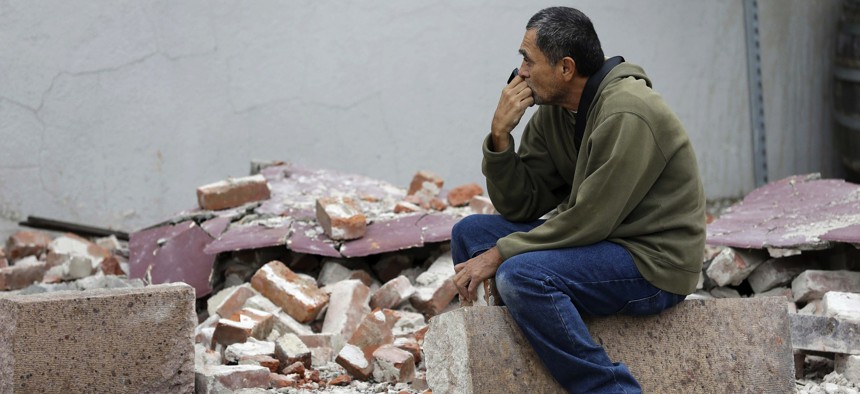Why There May Never Be a Final Price Tag on Last Year’s Napa County Earthquake

Ron Peralez, of Vacaville, Calif., sits on rubble and looks at earthquake-damaged buildings Monday, Aug. 25, 2014, in Napa, Calif. Eric Risberg / AP Photo

Connecting state and local government leaders
A year after a magnitude 6.0 seismic event did a lot of damage, it's difficult to calculate the disaster’s total costs.
A year ago, a magnitude 6.0 earthquake rocked Napa County, California, north of San Francisco. While the early morning seismic event on Aug. 24, 2014, didn’t unleash widespread destruction throughout the county—the quake was the largest in the San Francisco Bay area since the magnitude 6.9 Loma Prieta earthquake in 1989—it packed a powerful punch nonetheless.
One death was attributed to the earthquake, a 65-year-old woman who was hit by a television set during the shaking.
But assessing the full scope of the damages, just how costly was the earthquake?
As the Napa Valley Register reports, that’s a difficult task and depends on variety of factors. For damage within the county itself, estimates range from $442.7 million to $800 million. And getting those estimates are important for starting the process to obtain state and federal disaster aid.
But there may never be one final amount.
According to the Register:
[Napa County Risk and Emergency Manager Kerry John] Whitney knows of no agency today that is calculating overall South Napa earthquake losses. The county and city made their initial estimate with a now-achieved purpose in mind—securing disaster area status and federal and state aid. They have no reason to revisit the issue.
Easier to assess is the amount of earthquake aid that flowed to private parties, since the application periods are closed. Recent reports by federal agencies and a local foundation place the number at $57 million to help residents and business owners.
FEMA reported that 7,300 people registered for earthquake aid. The agency awarded about $11 million in grants for such things as repairing homes and rental assistance. It offered grants of up to $32,900.
In addition, the U.S. Small Business Administration reported receiving 1,652 applications for home loans and approving 968 for a total of $30.5 million. It reported receiving 249 business loan applications and approving 124 for a total of $9.5 million.
As Route Fifty reported earlier this year, the quake had a big impact on Napa County government operations, with the designated emergency operations center site in a county administration building sustaining damage, forcing officials to regroup at the sheriff’s department as the disaster response was unfolding. (That also required having a flexible mobile strategy that allowed IT staff to get key systems back up and running quickly.)
The Times-Herald of Vallejo details more of damage and disruption to county buildings and operations.
Home to most public services, the Carithers Building at 931 Parkway Mall, suffered mostly water damage, [Napa County public information officer Kristi] Jourdan said, displacing 400 county employees, including the board of supervisors. The administration building at 1195 Third St. also suffered water damage, collapsed ceilings and walls.
Fortunately, a building had already been purchased before the quake where employees were relocated, Jourdan said.
A section of the Napa County jail was also damaged, forcing the relocation of about 50 inmates to Solano County Jail in Fairfield. Repairs are pending FEMA approval for the Napa jail and county courthouse, Jourdan said.
The earthquake a year ago was an unpleasant reminder of the vulnerability much of California faces from natural disasters, and recent smaller quakes along the Hayward Fault closer to San Francisco reinforce the need to be prepared.
Napa County, despite sustaining significant damage from last year’s quake, in some ways escaped a much worse disaster. But it was a very good test run for something larger and far more destructive.
It’s all a matter of when and where the next big emergency will play out in California.
Michael Grass is Executive Editor of Government Executive’s Route Fifty.

NEXT STORY: Too Many Dead Dogs in Dallas; SoCal Water District’s Short-Shower Playlist





